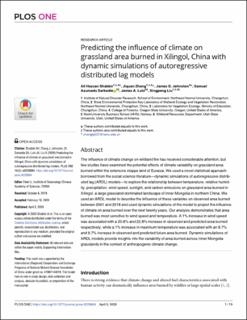| dc.contributor.author | Shabbir, Ali Hassan | |
| dc.contributor.author | Zhang, Jiquan | |
| dc.contributor.author | Johnston, James D. | |
| dc.contributor.author | Sarkodie, Samuel Asumadu | |
| dc.contributor.author | Lutz, James A. | |
| dc.contributor.author | Liu, Xingpeng | |
| dc.date.accessioned | 2020-07-09T14:29:13Z | |
| dc.date.available | 2020-07-09T14:29:13Z | |
| dc.date.created | 2020-04-04T20:20:58Z | |
| dc.date.issued | 2020 | |
| dc.identifier.citation | Shabbir, A: H., Zhang, J., Johnston, J. D., Sarkodie, S. A., Lutz, J. A. & Liu, X. (2020). Predicting the influence of climate on grassland area burned in Xilingol, China with dynamic simulations of autoregressive distributed lag models. PLOS ONE, 15(4): e0229894. doi: | en_US |
| dc.identifier.issn | 1932-6203 | |
| dc.identifier.uri | https://hdl.handle.net/11250/2663572 | |
| dc.description.abstract | The influence of climate change on wildland fire has received considerable attention, but few studies have examined the potential effects of climate variability on grassland area burned within the extensive steppe land of Eurasia. We used a novel statistical approach borrowed from the social science literature—dynamic simulations of autoregressive distributed lag (ARDL) models—to explore the relationship between temperature, relative humidity, precipitation, wind speed, sunlight, and carbon emissions on grassland area burned in Xilingol, a large grassland-dominated landscape of Inner Mongolia in northern China. We used an ARDL model to describe the influence of these variables on observed area burned between 2001 and 2018 and used dynamic simulations of the model to project the influence of climate on area burned over the next twenty years. Our analysis demonstrates that area burned was most sensitive to wind speed and temperature. A 1% increase in wind speed was associated with a 20.8% and 22.8% increase in observed and predicted area burned respectively, while a 1% increase in maximum temperature was associated with an 8.7% and 9.7% increase in observed and predicted future area burned. Dynamic simulations of ARDL models provide insights into the variability of area burned across Inner Mongolia grasslands in the context of anthropogenic climate change. | en_US |
| dc.language.iso | eng | en_US |
| dc.publisher | Public Library of Science | en_US |
| dc.rights | Navngivelse 4.0 Internasjonal | * |
| dc.rights.uri | http://creativecommons.org/licenses/by/4.0/deed.no | * |
| dc.title | Predicting the influence of climate on grassland area burned in Xilingol, China with dynamic simulations of autoregressive distributed lag models | en_US |
| dc.type | Peer reviewed | en_US |
| dc.type | Journal article | en_US |
| dc.description.version | publishedVersion | en_US |
| dc.rights.holder | © 2020 The Author(s) | en_US |
| dc.subject.nsi | VDP::Matematikk og Naturvitenskap: 400::Matematikk: 410::Statistikk: 412 | en_US |
| dc.source.pagenumber | 19 | en_US |
| dc.source.volume | 15 | en_US |
| dc.source.journal | PLOS ONE | en_US |
| dc.source.issue | 4 | en_US |
| dc.identifier.doi | 10.1371/journal.pone.0229894 | |
| dc.identifier.cristin | 1805308 | |
| dc.relation.project | International (Regional) Cooperation and Exchange Programs of National Natural Science Foundation of China: 41961144019 | en_US |

